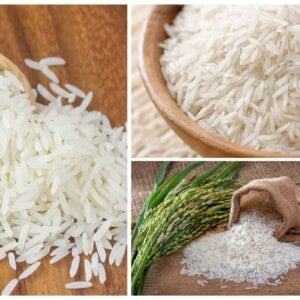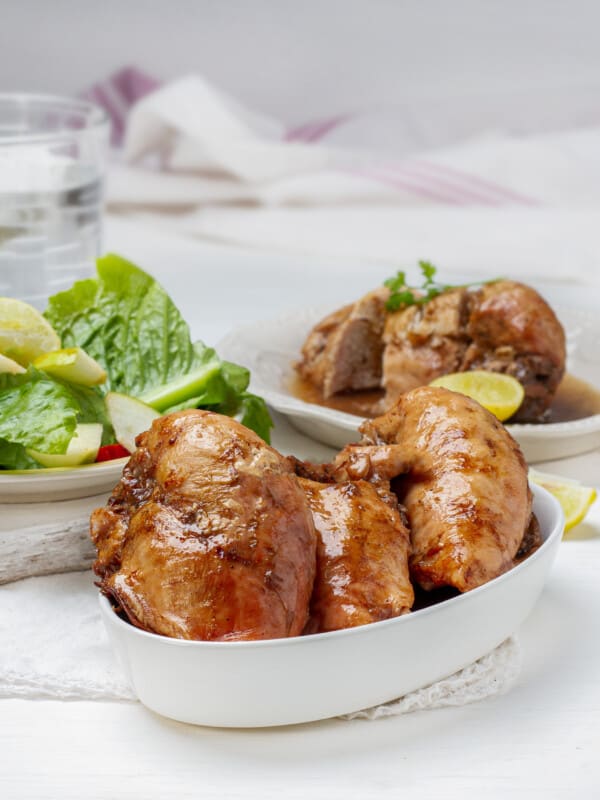Rice, a staple food for more than half of the world’s population, comes in numerous varieties, each with its unique flavor, texture, and culinary applications. However, when it comes to aromatic rice, two varieties top the charts: Basmati and Jasmine. Here, we’ll delve deep into the nuances of these two popular rice types and help you discern the differences, from their distinct characteristics to culinary uses and health benefits.
Basmati vs. Jasmine Rice
Basmati and Jasmine rice are among the most fragrant and aromatic varieties on the planet and are renowned for their fragrant appeal and wonderful flavor profiles. Basmati is often associated with Indian and Pakistani cuisine and is a long-grained rice variety that has a very delicate flavor. Jasmine rice, on the other hand, is native to Thailand and is shorter, stickier, and has a sweeter, almost nutty aroma.
The biggest choice between the two types often boils down to the specific dish or culinary application, personal preference, and of course, which distinct taste is desired. The intriguing battle of Basmati vs. Jasmine rice isn’t only about choosing one over the other, it’s about understanding and appreciating the unique character that each one brings to your dish.
What is Basmati Rice?
Sometimes referred to as the “prince of rice”, Basmati rice can trace its roots back to the fertile Himalayan foothills of India and Pakistan. It’s held a prestigious place in countless cuisines across the Middle East, Central Asia, and the Indian subcontinent.
Basmati is highly aromatic and is usually recognized by the fluffy, non-sticky texture following cooking, as well as the long grains. This makes it the ideal companion for dishes like curries, biryanis, pilafs, and salads. It is nutritionally rich, has significant fiber, as well as a low Glycemic Index (GI) score, making it a great choice for those with blood sugar issues.
Different Types of Basmati
Even though all Basmati rice will share similar aroma and shape characteristics, it does come in multiple varieties that each have their unique attributes.
- White Basmati: The most common variety, and what you’ll generally see in stores, is aged for several months to enhance the aroma and flavor.
- Brown Basmati: Less processed than its white counterpart, this Basmati varietal retains the bran layer, which adds a nuttier flavor and increases fiber content.
- Golden Sella Basmati: This is parboiled basmati, which maintains a golden hue post-cooking. It’s popular for its low GI and firm texture.
- Wild Basmati: Also known as black basmati, this is a whole-grain variety with a unique, exotic flavor.
How Do You Make Basmati Rice?
Cooking Basmati rice is an art, disguised as a science. Here’s a simple way to ensure it comes out perfectly:
- First is the rinse. Soak the Basmati in cold water for 20-30 minutes, then rinse until the water runs clear, to remove excess starch and prevent stickiness.
- Next, add the rice to a pot, in a ratio of 1:1.5 rice to water, and add a pinch of salt.
- Now bring the water to a boil, then reduce the heat, cover, and simmer for 15 minutes.
- Then you’ll turn off the heat and let the rice rest, covered, for between 5 and 10 minutes to allow the grains to firm up.
- The last step is to gently fluff the rice with a fork before serving.
Delicious Basmati Ingredients
Basmati rice’s delicate flavor profile makes it the perfect canvas for various ingredients. Enhance your basmati dish with:
- Spices: Add cardamom, cloves, cumin, or cinnamon for a boost of flavor.
- Herbs: Fresh cilantro or mint lends a refreshing touch.
- Nuts and Dry Fruits: Almonds, cashews, raisins, or dried cranberries provide a delightful crunch and sweetness.
- Sauces: Soy sauce, coconut milk, or curry paste can add depth and richness.
- Protein: Basmati pairs well with chicken, lamb, shrimp, tofu, or chickpeas.
- Vegetables: Mix in sautéed onions, bell peppers, peas, or carrots for a nutritious and colorful addition.
Great Basmati Recipes You Should Try
- Chicken Biryani: A savory Indian dish where basmati rice is layered with spiced chicken and cooked in a sealed pot to infuse flavors.
- Pilaf: Basmati rice cooked with broth, vegetables, and spices. It’s a versatile dish that can be adapted to any cuisine.
- Jeera Rice: Simple yet delicious, jeera (cumin) rice pairs well with curry dishes.
- Thai Basil Fried Rice: A fusion dish where basmati rice is stir-fried with Thai basil and a medley of vegetables and proteins.
- Basmati Rice Pudding: A creamy dessert made with basmati rice, milk, and sugar, and flavored with cardamom and saffron.
What is Jasmine Rice?
Jasmine rice, also known as Thai fragrant rice, comes from the verdant fields of Thailand. It’s commonly linked to Southeast Asian cuisine and is particularly loved for its fragrant, floral aroma, reminiscent of Jasmine flowers. The grains of Jasmine rice are shorter and rounder than Basmati, with a slightly glossy appearance.
Jasmine is a very sticky rice, which makes it perfect for dishes like sushi or sticky rice desserts. Like Basmati, it’s nutritionally dense, but it has a higher GI score and lower fiber. The aroma, flavor, and tender texture are the biggest reasons it remains a globally celebrated rice variety.
Different Types of Jasmine Rice
Just like Basmati, Jasmine rice is available in several distinct varieties, with each being noticeably different from the others.
- White Jasmine Rice: This is the most common variety, and it’s known for its floral aroma and delicate flavor.
- Brown Jasmine Rice: This form is processed less, and contains the bran layer, which increases fiber content and gives it a nuttier overall flavor.
- Black Jasmine Rice: Also known as “forbidden Rice”, this type has a deep black color that turns purple upon cooking and has a slightly sweet flavor.
- Red Jasmine Rice: This type is similar to brown but has a reddish hue. It’s whole-grain, rich in fiber, and has a robust, earthy flavor.
How Do You Make Jasmine Rice?
Making Jasmine rice is slightly easier than Basmati. Here’s a rundown for making the perfect pot.
- First rinse the rice in cold water until the water is clear, to remove excess starch, though soaking isn’t needed.
- Now add the rice to a pot in a 1:1.5 water to rice ratio, with a bit of salt.
- Now bring the pot to a boil, and once boiling reduce the heat, cover, and simmer for 15 minutes.
- Let the rice rest for 10 minutes in the covered pot.
- Finally, fluff with a fork before serving.
Delicious Jasmine Rice Ingredients
Jasmine rice can be seasoned and garnished with a variety of ingredients, making it a versatile staple:
- Aromatics: Garlic, ginger, lemongrass, and kaffir lime leaves can boost the fragrance of your Jasmine rice.
- Spices: Try adding turmeric for a yellow Jasmine rice, or star anise and cinnamon for an Asian twist.
- Herbs: Fresh basil, cilantro, and green onions can add color and freshness.
- Sauces: Soy sauce, fish sauce, or oyster sauce can provide a savory flavor.
- Protein: Prawns, chicken, tofu, or eggs work excellently with Jasmine rice.
- Vegetables: Peas, bell peppers, or broccoli can be mixed in for added nutrition and flavor
Great Jasmine Rice Recipes You Should Try
- Thai Fried Rice: A vibrant dish where Jasmine rice is stir-fried with egg, vegetables, and a choice of protein.
- Coconut Rice: Jasmine rice cooked in coconut milk, often served with tropical dishes.
- Green Curry Rice: Jasmine rice infused with green curry paste and cooked with vegetables and protein.
- Mango Sticky Rice: A popular Thai dessert, featuring sticky Jasmine rice served with ripe mango slices and sweetened coconut cream.
- Hainanese Chicken Rice: A Singaporean dish where Jasmine rice is cooked in chicken broth, ginger, and garlic, paired with poached chicken and chili sauce.
Wrapping Up: What are the Key Differences Between Basmati and Jasmine Rice?
In this culinary comparison between Basmati and Jasmine rice, it’s obvious that both varieties bring their unique characteristics to the table. Basmati with its long and slender grains, distinct aroma, and non-sticky texture, is an incredibly popular favorite in Indian and Middle Eastern cuisines. On the other hand, the versatile Jasmine rice, with its more subtle aroma, tender, sticky texture, and versatility is an absolute star in Southeast Asian cooking.
In the end, the choice between Basmati and Jasmine rice is largely going to depend on the type of dish you’re preparing, your dietary plan, and your personal preferences. Both rice varieties will add their touch of aromatic indulgence to every dish.
Frequently Asked Questions
Q1: Is Basmati or Jasmine Rice healthier?
Both Basmati and Jasmine rice have their health benefits. Basmati has a lower glycemic index and is rich in fiber, which aids digestion. Jasmine rice is a good source of carbohydrates and protein. The healthiest choice depends on your specific dietary needs.
Q2: Can I substitute Jasmine for Basmati rice?
While Jasmine and Basmati rice have distinct flavors and textures, they can be substituted for each other in most recipes. However, the result may not perfectly replicate the original dish due to the differences in aroma, texture, and flavor.
Q3: Which rice is best for diabetics, Basmati or Jasmine?
Basmati rice, especially the brown variety, is generally recommended for people managing their blood sugar levels due to its lower glycemic index compared to Jasmine rice.
Basmati vs Jasmine Rice

Instructions
- Choose your favorite recipe
- Click the link to view the recipe instructions
- Follow the linked instructions
- Enjoy!





